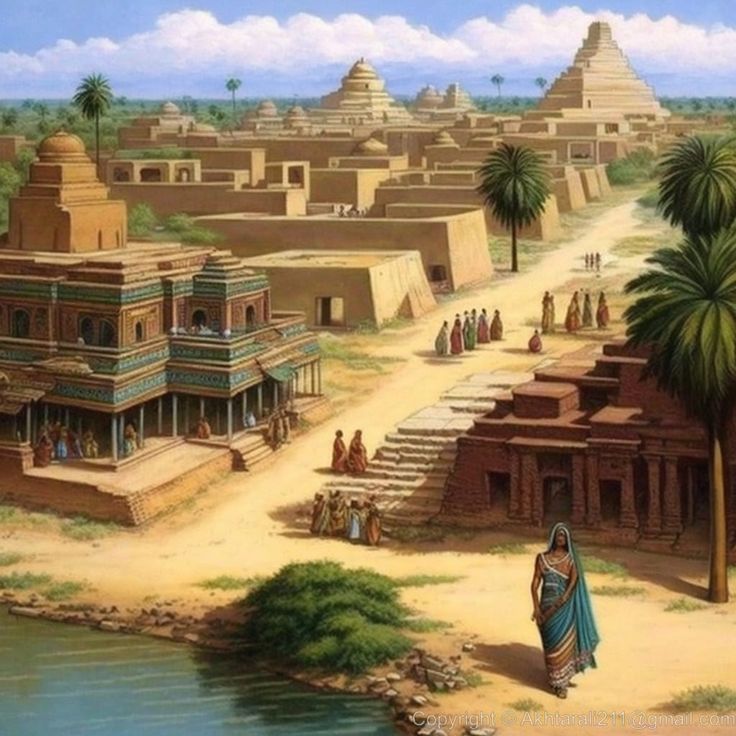Saraswati Sindhu Civilization : Future Directions
Introduction
Some of the most sophisticated and powerful civilizations in human history have found home in the Indian subcontinent. Among these, the Sarasvati-Sindhu (or Indus-Sarasvati) Civilization is especially a real wonder of the ancient world. At its height spanning more than a million square kilometers, this enormous cultural and economic powerhouse thrived for more than a millennium, permanently changing the area and the globe at large.
Rising from the lush banks of the powerful Sarasvati and Sindhu (Indus) rivers in 7000 BCE, this ancient culture rapidly grew to be among the biggest and most advanced of its time, surpassing the achievements of Egypt and Mesopotamia. Scholars and historians have been enthralled for decades by its vast metropolitan centers, complex trade networks, and innovative technological ideas, which also help to clarify the sources of Indian culture and its worldwide impact.
We examine in great detail the fascinating history, outstanding achievements, and legacy of the Sarasvati-Sindhu Civilization, so attesting to the inventiveness and tenacity of the people who formerly lived in this area.
The Contextual Geography and Environment
Driven by the rich water supplies of the Sarasvati and Sindhu river systems, the Sarasvati-Sindhu Civilization thrived on the lush plains of the Indian subcontinent. Between the great Arabian Sea to the south and the soaring Himalayas to the north, this area offered the perfect environment for the emergence of a rich agricultural community.
Often called the “abode of snow” in Sanskrit, the Himalayas were absolutely vital in forming the hydrology and temperature of the area. Created by the collision of the Indian and Eurasian tectonic plates, this enormous mountain range functioned as a barrier keeping warm, moist air from the south and causing it to fall as torrential monsoon rain. Feeding the Sarasvati, Sindhu, and their many tributaries, these seasonal downpours produced a rich, flood-prone terrain ideal for the growing of a wide range of crops.

The strategic location of the area also helped to promote significant economic and cultural interaction with surrounding societies. Nestled at the junction of ancient Eurasia, the Sarasvati-Sindhu Civilization developed important maritime and overland trade routes linking it to the Near East, Central Asia, and even the Far East, so promoting a rich flow of products, ideas, and technology.
The Sarasvati-Sindhu Civilization’s Emergence and Growth
The Neolithic villages that arose in the area circa 7000 BCE provide the roots of the Sarasvati-Sindhu Civilization. Over the next millennium, these early societies—which were distinguished by their mastery of agriculture, pottery-making, and primitive metallurgy—gradually came together into bigger, more advanced civilizations.
Entering its “Early Harappan” phase around the middle of the third millennium BCE, the Sarasvati-Sindhu Civilization was distinguished by the construction of planned urban centers, advanced infrastructure, and a uniform system of weights and measurements. Two of the most well-known sites from this age, Harappa and Mohenjo-daro, displayed the excellent urban planning of the civilization with well-ordered street grids, drainage systems, and the first known instances of municipal sanitation.
The civilization grew more widely as it developed, building a network of little towns and trading outposts all throughout the Indian subcontinent and beyond. Over one million square kilometers and with an estimated population of five million, the Sarasvati-Sindhu Civilization had expanded to become the biggest and most developed of its time by the height of its “Mature Harappan” era (c. 2600–1900 BCE).

Technological and Cultural Achievements
Renowned for its scientific and cultural complexity, the Sarasvati-Sindhu Civilization greatly beyond many modern societies. From urban design and architecture to agriculture, metallurgy, and trade, its people were trailblazers in a broad spectrum.
The Sarasvati-Sindhu people were among the most remarkable masters of infrastructure and urban design. With large, well-planned streets, complex drainage systems, and even the first known instances of municipal sanitation, their cities—including Harappa and Mohenjo-daro—were set up in a grid-like arrangement. Additionally displaying their sophisticated building methods were the usage of uniform bricks and the construction of multi-story buildings.

Regarding agriculture, the Sarasvati-Sindhu Civilization was a genuine inventor. To guarantee a consistent food supply, they established sophisticated irrigation and storage systems and created a varied array of crops including wheat, barley, rice, and cotton. Their expertise of metallurgy—shown by the manufacture of bronze tools and weapons—also helped them to establish a flourishing trading network linking them to far-off societies.
Developing a uniform system of weights and measurements employed in their great trading activity, the Sarasvati-Sindhu people were also pioneers in the realm of mathematics and metrology. Reflecting their excellent knowledge of measurement and geometry, archaeologists have found a wonderfully exact ivory scale etched with almost 30 divisions placed at consistent intervals of just 1.704 millimeters.
Beyond their technical ability, the Sarasvati-Sindhu Civilization made major contributions to the field of art and culture. While the discovery of proto-Shiva figurines and meditation poses reveals the early roots of yoga and spiritual activities that would eventually become central to Indian society, their seals, beads, and pottery highlight a rich artistic legacy.
The Indus Script’s Mysterious Nature
The Indus Script, a sophisticated system of symbols and glyphs still not completely understood, is among the most fascinating and lasting puzzles of the Sarasvati-Sindhu Civilization. Found on seals, pottery, and other objects, this writing system—one of the first known in the ancient world—has enthralled academics for decades.
The exact meaning and purpose of the Indus Script remain obscure even with much study and investigation. From it being a proto-Dravidian language to a sophisticated system of trade and record-keeping, academics have put out several ideas. Since the evolution of a writing system is usually seen as a trademark of sophisticated civilizations, the discovery of the Indus Script has also resulted in the appreciation of the advanced intellectual and cultural achievements of the Sarasvati-Sindhu Civilization.
Unlocking a wealth of knowledge about the Sarasvati-Sindhu Civilization, its social organization, religious beliefs, and commercial activity, the ongoing efforts to decipher the Indus Script promise The world awaits the day when the mysteries of the Indus Script will be disclosed as fresh archaeological finds and technology developments keep illuminating this mysterious writing system.
Trade, industry, and the Sarasvati-Sindhu worldwide influence
Apart from being a technological and cultural powerhouse, the Sarasvati-Sindhu Civilization was a key commercial center keeping vast trading routes around the ancient globe. The Sarasvati-Sindhu people’s advantageous location at the crossroads of Eurasia and their sophisticated maritime and overland transportation capacity let them create extensive trading contacts with societies as far-off as Mesopotamia, the Persian Gulf, and even the Levant.
Seals, beads, and pottery among other objects have been found by archaeologists that support the great trading operations of the Sarasvati-Sindhu Civilization. In return for bronze, tin, silver, lapis lazuli, and soapstone from far-off areas, they exported a broad spectrum of items including gold, copper, lumber, ivory, and the treasured Harappan carnelian beads.

The Sarasvati-Sindhu people were especially remarkable in their skill of sailing and navigation; they could travel great distances utilizing cutting-edge methods including the usage of conch shell compasses to gauge angles between stars. Strategically positioned along these vast trade routes, their commercial outposts—that of Shortugai in Afghanistan—helped to ease the flow of commodities and ideas.
As the Sarasvati-Sindhu Civilization established the area as a center of international trade and cultural interaction, its worldwide reach and commercial might set the groundwork for the future wealth of the Indian subcontinent. For millennia to come, its legacy would still be guiding South Asian history.
The Fall and Vanishes of the Sarasvati-Sindhu Civilization
The Sarasvati-Sindhu Civilization left a complicated and mysterious legacy even though it had amazing achievements and lifetime. It finally collapsed in 1900 BCE. Scholars have argued much about the causes of its fall; several ideas have been put up to explain this historical mystery.
One of the main theories holds that the civilization’s collapse may have been caused in great part by the slow drying out of the Sarasvati River brought on by tectonic movements and climatic change. Along with the changing course of the Sindhu River, the loss of this essential water source most certainly upset the delicate agricultural and commercial networks keeping the Sarasvati-Sindhu people afloat for millennia.

The migration of nomadic groups, such the Aryans, who progressively settled within the area and would have upset the current social and political system, was another element influencing the fall of the civilization. With their unique cultural and technological traditions, the blending of these new groups could have caused social unrest and finally brought about the fall of the Sarasvati-Sindhu Civilization.
The Sarasvati-Sindhu Civilization leaves behind a legacy that is evident in the religious, linguistic, and cultural traditions that have survived millennia on the Indian subcontinent notwithstanding its ultimate collapse. The discovery and continuous research of this prehistoric civilization keeps throwing fresh light on the beginnings and development of one of the most powerful and ancient civilizations on earth.
Indian Culture’s Origins and the Sarasvati-Sindhu Civilization
It is impossible to overestimate how the Sarasvati-Sindhu Civilization shaped the religious and cultural customs of the Indian subcontinence. Among the first and most developed cultures in the area, it set the stage for many of the ideas, customs, and creative expressions that would define the Indian cultural scene.
Many relics and iconographic evidence point to the Sarasvati-Sindhu people’s intense participation in spiritual and religious activities according to archaeologists. Early Hindu traditions and the idea of the divine in Indian philosophy are suggested by the finding of proto-Shiva figurines and images of yogic postures and meditation practices.
Moreover, the complex infrastructure and well-organized towns of the Sarasvati-Sindhu Civilization’s excellent urban design might have shaped Indian society’s conception of the “sacred city”. Large community baths and other communal buildings help to symbolize the merging of religious and civic life, therefore hinting at the significant part temples and religious institutions would play in the social and cultural fabric of subsequent Indian civilizations.

Ongoing study and discussion surround the literary and linguistic heritage of the Sarasvati-Sindhu Civilization as well. Although the exact form of the Indus Script is still unknown, academics have suggested that it might have been a forerunner of the Dravidian languages, which have been so important in forming the linguistic variation of the Indian subcontinent.
Furthermore, the Vedas, the fundamental Hindu books, are thought to have been written on the banks of the Sarasvati and Sindhu rivers, hence strengthening the civilization’s continuing impact on the religious and spiritual life of India. The Vedas’ repeated references to the Sindhu River as well as the possible links between the Sarasvati-Sindhu Civilization and the beginnings of yoga and meditation point to the close ties between this ancient civilization and the legacy of Indian subcontinence.
Modern World and the Sarasvati-Sindhu Civilization
The influence of the Sarasvati-Sindhu Civilization goes well beyond the boundaries of the ancient world since it still shapes our knowledge of human history and the growth of contemporary civilizations. From archaeology and anthropology to linguistics and the history of science and technology, the revelations from the study of this extraordinary society have great ramifications for many other fields.
The Sarasvati-Sindhu Civilization made one of the most important contributions by pioneering early urban design and infrastructure. The sophisticated drainage systems, advanced city-building methods, and consistent weights and measurements used by the Sarasvati-Sindhu people predicted the development of contemporary urban planning and engineering methods. These developments highlight the ageless importance of the achievements of this ancient civilization since they have kept impacting the design and development of cities all across the world.

Furthermore, the large trade networks and worldwide reach of the Sarasvati-Sindhu Civilization have significant consequences for our knowledge of the beginnings of globalization and international trade. The evidence of long-distance sea and overland trade as well as the complex finance systems like the “Hundi Hawala” system point to ages past as the roots of contemporary global trade, far earlier than before believed.
Furthermore illuminating the development of human language, writing systems, and the beginnings of ancient knowledge systems are the continuous attempts to interpret the Indus Script and solve the puzzles of the intellectual and cultural traditions of the Sarasvati-Sindhu Civilization. The insights acquired as scientists keep delving into this rich reservoir of archeological and textual data could have broad ramifications for disciplines including linguistics, cognitive science, and the history of science.
Sindhi Community and the Sarasvati-Sindhu Civilization
For the Sindhi people, whose ancestral territory was the center of this ancient civilization, the legacy of the Sarasvati-Sindhu Civilization has especially great relevance. Originating in the area of Sindh (now mostly Pakistan), the Sindhi people have long been known for their entrepreneurial energy, financial sense, and fortitude against hardship.
Many academics agree that the unique cultural characteristics and accomplishments of the Sindhi people have clear roots in the Sarasvati-Sindhu Civilization. The focus on trade, business, and international connectivity that defined the ancient culture could have helped the Sindhis to establish themselves as successful businessmen and world traders. Likewise, the rich cultural and spiritual traditions of the civilization might have set the stage for the strong link of the Sindhi people to the arts, music, and religious rituals.

Furthermore, the lack of fortifications and weapons in the urban centers of the Sarasvati-Sindhu Civilization indicates their non-violence and peaceful cohabitation ethos, which might have affected the Sindhi community’s inclination for dispute resolution and flexibility in the face of difficulty. This natural tenacity and cultural continuity have helped the community to recover from the terrible events of the Partition of India in 1947 and create vibrant communities all throughout the world.
Rediscovery and study of the Sarasvati-Sindhu Civilization have become ever more crucial as the Sindhi community negotiates the demands of the modern world. Reconnecting with their ancestral roots and appreciating the rich legacy of their forefathers will help the Sindhi people to find inspiration and strength to protect their own identity and support the continuous cultural and economic growth of the Indian subcontinent.
Sarasvati-Sindhu Civilization Research: Future Directions
The future of study in this topic has great promise as the global interest in the Sarasvati-Sindhu Civilization keeps rising. Scholars are prepared to find even more about this amazing ancient society and its long-lasting influence on the planet with fresh archaeological finds, technological developments, and multidisciplinary partnerships.
Deciphering the Indus Script is one of the most fascinating frontiers in Sarasvati-Sindhu Civilization study. The effective decoding of this mysterious writing system could offer a lot of knowledge about the social, economic, and religious systems of the civilization as well as its contacts with other ancient societies. Novel ideas including the use of artificial intelligence and machine learning could open the mysteries of the Indus Script and transform our knowledge of this prehistoric society.
Furthermore, the use of modern scientific methods including DNA analysis and archaeo-metallurgical investigations promises to clarify the technological advances, migration patterns, and beginnings of the Sarasvati-Sindhu Civilization. These multidisciplinary projects including archaeologists, linguists, geneticists, and materials scientists will surely produce amazing findings challenging and improving our current knowledge.

The worldwide academic community keeps spending in the investigation and preservation of the rich legacy of the Sarasvati-Sindhu Civilization as it keeps investing in this regard. Initiatives such as the Taksha Indic Sarasvati-Sindhu Civilization (TISSC) Center have become centers of multidisciplinary research, encouraging cooperation among academics from many disciplines to solve the riddles of this ancient society.
The study of the customs, trade routes, and relationships with the Levant and the Ancient Far East of the Sarasvati-Sindhu Civilization forms the central focus of the TISSC Center’s work. Through an analysis of the vast trade channels linking this ancient civilization to far-off locations, scholars seek to better grasp how India evolved to rank as the biggest economy in the world during the first century CE.
The decipherment of the Indus Script Cipher, a sophisticated system of semantically layered inscriptions long escaped academics, is a major concentration of the activity of the TISSC Center. Using the most recent developments in artificial intelligence and machine learning, scientists hope to crack the code of this ancient writing system, so releasing a wealth of data on the social, religious, and economic life of the Sarasvati-Sindhu Civilization.
Beyond the Indus Script, the multidisciplinary approach of the TISSC Center investigates the interconnections of the civilization to the Dravidian culture as well as its possible connections to the beginnings of yoga, meditation, and other spiritual traditions that would later become central to Indian society. Through analysis of the archeological, linguistic, and iconographic data, the scientists hope to clarify the ongoing heritage of the Sarasvati-Sindhu people.
The TISSC Center seeks to involve the general population in the study of this ancient culture, therefore transcending intellectual interests. By means of seminars, conferences, and instructional initiatives, the center aims to increase respect for the contributions made by the Sarasvati-Sindhu Civilization to the planet and its ongoing significance in the present period.
The work of the TISSC Center and related studies projects promises to expose even more about this amazing ancient society as the worldwide community’s obsession with the Sarasvati-Sindhu Civilization continues to increase. Scholars and aficionados both can better grasp the basis upon which the rich cultural legacy of the Indian subcontinent was created by combining the shards of its history.
#Saraswati #sindu #civilization







